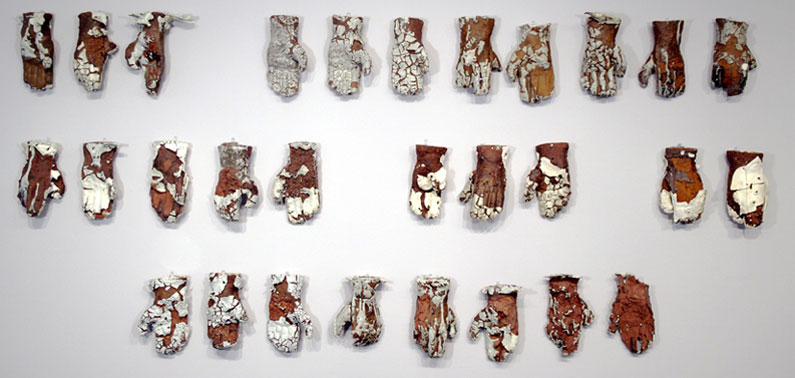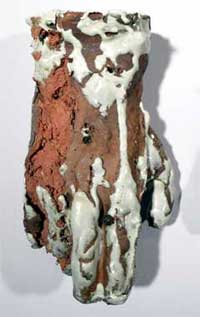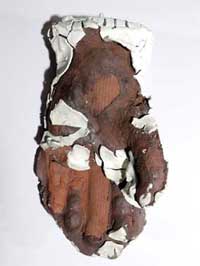 |
||
FRAGMENTED FIGURE |
| |
||||||||||
Babette Martini Exhibited Works |
||||||||||
|
||||||||||
| |
||||||||||
Fragmentation in Babette Martini’s Ceramicsby Natasha Mayo
|
||||||||||
|
Extract taken from Babette Martini’s conference paper: ‘The Body Undone – Fragmentation in Process’. To access the paper in its entirety select Martini’s link from the recommended reading list. Founded on the writings of Marx, Elaine Scarry discusses the correlation between acts of creativity and pain. Arguing that the artefact1 embodies the closely linked association of work and pain, the act of creating and pain become sharable within the artefact. Based on Scarry’s notion the paper analyses four examples of contemporary artistic practices, where the making of the figure and human body through fragments becomes an intrinsic method of the making of the figure. The paper proposes that through the artefact or figure the correlation between hurt and making becomes a sharable experience and significant expression of the figure… Scarry considers the Judeo-Christian sculptures as a narrative of the interior structure of making. Drawing on the old Testament Scarry equates the structure of believing to the structure of making, where the relationship between the primary artefact, God, and humans is often conceived by the sign of the weapon. She illustrates that God endlessly modifies man through illness, human labour, childbirth and catastrophes. Scarry’s examples elucidate that God shatters the human body and he rebuilds the body through granting fertility, for example. Therefore the making and unmaking of the human body mark the relationship with God, or with man. The mediated principal of creating within this relationship is symbolized by ‘the vertical line’ of a weapon whose one end reaches the ground, the concrete, and whose other extends into heaven, the ‘imaginable image and unimaginable’2. Hence another critical part of the relationship between God and man is that God’s presence is expressed in his, disembodied, voice and immunity to hurt in contrast to the intense bodily and suffering materialisation of man.3 Therefore by wounding and undoing his creation, God the disembodied voice, substantiates himself within the sentient human body, which becomes particularly crucial in moments of doubt.4 Thus this ‘wounding re-enacts the creation because it re-enacts the power of alteration that has its first profound occurrence in creation’.5 Hence it is the human body which substantiates the divine presence and its realness. Its bodily experience is not sensed as a reality of the body but as a quality of its ‘metaphysical referent’.6 The ongoing modulation of an original creation of God, man, demonstrates that the principal of making is based on the fragmentation of the artefact. This principal becomes especially in Christie Brown’s process a dominant feature as she makes the figure in several moulds. The moulds started as a technical solution but gained more and more a metaphorical association. For her they represent repetition, trauma, cloning hence the inherent fragmentation of the human body through the applied process becomes a major means of expression in her work. When observing Brown during the making of the piece ‘Ex Voto-Insignificance’ (2003) it becomes evident that the fragmentation in her work occurs on several levels as the segmentation of the figure starts already with the lining of the moulds. Several clay slabs are individually lowered and pressed into the mould. Thus each mould, which is often part of a limb as the upper thigh for example, consists in itself of a number of segments. Looking at the moulds, which become reminiscent of body limbs cut in half lengthwise, the red ceramic material appears to be the inner fleshy lining of these body fragments and transmit the impression of looking at the inverted and thus interior body. And it is on this inner side where Brown applies the pressure with a small sponge to shape and overlap the individual clay segments onto the whole of the mould. Hence the fragmentation of the figure during the process appears to consist not only in the division of the body but as well in the division between the inside and the outside. The division between the inside and the outside of the artefact and its forming on both sides is described by Scarry as important as it is an inherent part of God’s making of man. To be embodied means ‘to be describable, creatable, alterable, and woundable’ and thus the human existence appears to be extremely vulnerable and susceptible to fragmentation.7 The failure of belief heightens the importance of the interior body. According to the old scriptures belief is the act of turning inside out and exposing it to the ultimate exterior surface of God. It is thought that through the inversion of one’s body, or ‘the imagining’, creates ‘the capacity for symbolic and religious thought’ and the capacity to link interior events with exterior, non-physical cause.8 Therefore God remakes not only the outer layer of the human body but also works on the interior tissue of the body. This moment of inversion appears to be the most crucial one in the making of man, as Scarry describes it as a moment of self sacrifice and ‘the two extreme forms of alteration, self-replication and wounding, converge’.9 Consequently the human form appears to originate mainly from the working on inside or the inverted outside. One gains a similar impression when observing Brown joining and carefully overlapping the seams of the clay slabs inside the mould as these seams determine the stability of her figure. Within the context of ‘Ex Voto-Insignificance’ (2003), the lining up of the individual clay segments look like and act like sinews. These sinews seem to have a dividing function, as they visually segment the surface, and unifying function, as the figure is held together at these crucial points. Moreover, these sinews create a dialogue between the formed exterior formed by the mould and the interior of the piece, formed by Brown, which would be revealed when the seams became undone. The breaking apart of the figure would expose the indentations left behind by Brown’s fingers in order to fuse the clay segments and the traces of the sponge, pushing the clay into the mould. Furthermore it would become evident that essentially Brown’s figure is shaped from this pressure within, so that maximum contact with the plaster wall of the mould is generated. With the perception of an interior, symbolised through the fragmentation noticeable on the outside, the formed figure is no longer just a replicated artefact but moves into the realm of a sentient being. Hence the fragment becomes in Brown’s work a significant lead into the interior of the human body and its history of making. The process of making man appears endless and never finished, as God asserts himself repeatedly. In addition, Scarry argues that having a body ‘makes one susceptible to the original alteration of having been created, and that makes one susceptible to subsequent alterations.10 Returning to Brown’s work, the forming of the figure through the individual segments visible through the seams and sinews in Ex Voto-Insignificance’ (2003) appear to signify not only the vulnerability of the human body, but also a state of being ‘unfinished’. Considering that Brown recognises analogies to the human existence in her process of layering the clay into the mould and that the mould itself stands for fundamental human feelings or conditions, the fragmented figure in Brown’s work turns into an image of repeated reinterpretation, and the fragment becomes a pars pro toto for the body and its experience of the human condition. Extract taken from Babette Martini’s conference paper: ‘The Body Undone – Fragmentation In Process’. To access the paper in its entirety select Martini’s link from the recommended reading list. The work examines how the heavily industrial process of the steelworks forms the human body, the labourer’s body. The correlation between the worker and the harsh environment is represented through the glove protecting the hand. Thus the relationship between the outer glove and the inner hand is the main subject of the work. The work denotes two kinds of fragmentation. The first refers to the working conditions of the steel worker himself. Compared with the narrations of the old Testament where physical wounding substantiates the original artefact, Scarry describes making in industrialization as a situation of intensified suffering and bodily alterations in order ‘to sustain and perpetuate’ the existence of this distressing circumstance (Scarry, 1987, p276). The breakdown of the original principal of making resulting in unreciprocated labour is also the cause for the alteration and forming of the labourers body. The increasing specialisation and division of the production turns the worker into an artefact himself. As Marx describes: ‘The habit of doing one thing converts him into a never failing instrument, while his connexion (sic) with the whole mechanism compels him to work with regularity on the parts of the machine’ (Marx, 1974, vol. 1, p330). But Furthermore, the industrial world could be comprehended as a mould or a glove forming the human body, and hence the research explores particularly methods of casting and this leads to the second aspect of fragmentation, which can be found within the employed processes. In order to form the inner hand a press mould is used and charged with different materials including liquid clay and combustibles. When filling the mould with these various components the mould acts as an implement to fuse these various components into a hand Particularly an industry, including steel manufacture, the mould is used a s a means for reproducing repeatable results. As Marx explains, the productiveness of the industry relies on the specialised tailoring of one tool to one function (Marx, 1974, vol. 1, pp322-323). However, within the artistic process, when the hand is being removed from the mould, on many occasions, the materials stick to the inner walls of the mould, thus producing an incomplete object. The same gypsum material which produces the cast, tears with decreasing absorbency the outer skin of the reproduced hand, revealing the interior structure. It therefore appears that the mould in this instance performs more that one function as it not only reproduced a hand in clay but also appears to interact with the medium and two functions could be described as the making (replication) and unmaking (interaction) of the same object. Thus the function of the tool seems to be no longer so specialised Returning to Scarry’s notion of the tool and the weapon, the mould turns into a weapon as it inflicts wounds or sentience and one could portray the hand as mutilated through this process. Furthermore the impression is transmitted that the hand is vulnerable as the labourer’s hand.
|
|
Recommended Reading Published on ICRC: Babette Martini:
Virginia Macsymowicz:
Sheila Gaffney: Fragment in the Fragment in the Construction of a Social Sculptural Object Gavin Younge: Lisa Hockemeyer:
Foot notes1. Scarry, E., The Body in Pain, Oxford University Press, 1987, pp170-171). back to text 2. Ibid, p. 173. back to text 3. Ibid, pp. 173, 183 and 192. back to text 4. Ibid, p. 200. back to text 5. Ibid, p. 183. back to text 6. Ibid, p. 206. back to text 7. Ibid, p. 206. back to text 8. Ibid, p. 190. back to text 9. Ibid, p. 204. back to text 10. Ibid, p. 193. back to text
|
||||||||
| |
||||||||||
| University of Wales Intitute, cardiff | Adorfa Prifysgol Cymru, Caerdydd | ||||||||||


